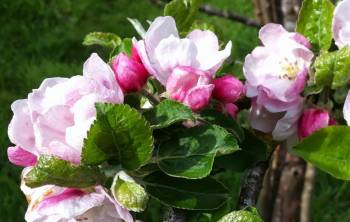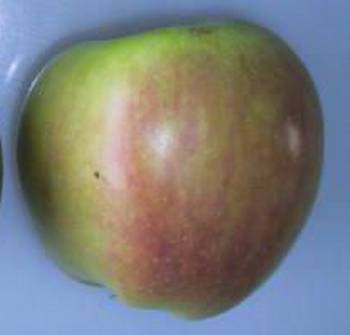PARENTAGE
The parents of the Lord Derby apple are Catshead (see Brogdale) and an unknown variety. It was raised in Stockport, originally on the border of Cheshire and Lancashire, but that area is now in Greater Manchester. Why it is called Lord Derby (Derby is some 90 miles to the east of Stockport) is unknown.
First recorded in 1862, it was described in the fifth edition (1884) of Hoggs Fruit Manual as “An excellent culinary apple; in use up till Christmas. It is a good deal like Gloria Mundi, and sometimes grows to an enormous size. I have them this year (1883) four inches in diameter, and the same in height.”
APPEARANCE, TASTE AND CHARACTERISTICS OF LORD DERBY
Before the apples even start forming, the blossom of Lord Derby is a treat. It’s very deep pink before the flowers open, followed by pale pink petals with deep pink backs to them. Impressive as the picture below shows.

Picture Courtesy of B-rittany-log-blogspot
The apples are on the large size, even for a cooker, with a green skin which turns yellow as it ripens. For most, even when fully ripe, the apples are too acidic for eating but they are excellent as cookers. Expect the flesh to puree down nicely when cooked, it retains very little of the uncooked shape.
No apple tree is impervious to scab but Lord Derby shows great resistance to it. It shows the same resistance to canker and powdery mildew. Because of its high levels of disease resistance this is a variety very well suited to growing in the North England and wet areas, although it grows equally well throughout the UK. It flowers later than many varieties and the blossoms resist a late frost well.
The tree is a strong grower and will begin to produce fruit two years after planting. If you are an amateur gardener looking for an easy to grow cooking apple tree we highly recommend this variety. The apples are normally ready for harvest from mid October to early November – see below for more specific details/
The apples are normally ready for eating from mid October to early November depending on which part of the UK you live in.

Lord Derby apple
Picture from public sector information licensed under the Open Government Licence v2.0.
BUYING A LORD DERBY APPLE TREE
Lord Derby is not one of those varieties which the supermarkets or DIY stores sell nor is it likely to be found in the mainstream garden centres. However it can easily be found online at a number of well-known suppliers.
SUMMARY CHARACTERISTICS OF LORD DERBY
USE: Cooker
SKIN COLOUR / TEXTURE: Green skin, can be flushed slightly red
FLESH COLOUR: Crisp white
TASTE AND TEXTURE: Good flavour, average acidity for a cooking apple
FRUIT SIZE: Larger than normal
STORAGE QUALITIES: Four to six weeks
SUITABILITY FOR CORDON / ESPALIER GROWTH: Yes
TREE SIZE: Strong grower producing a slightly larger than average tree
REGULARITY OF CROPPING: Very regular
POLLINATION: Group 4. It is self-sterile and needs a suitable pollination partner to produce fruit.
AWARDS: None
SPECIAL FEATURES: Top quality disease resistance combined with good taste for cooking.
LORD DERBY FLOWERING AND HARVEST TIMES:
The average flowering time (optimum time for pollination) and date when fruits are ripe in the UK for the Lord Derby apple tree are set out below. If you have set your home town we can give you a more accurate estimate, if you have not set your home town (do it now by clicking here) the dates below will be the average for the UK.
Your town has not been set, the average main flowering time for Lord Derby
in the UK is the third to fourth week of May. Fruit will be ready for harvesting in the last week of October.
Click here if you want to set the dates to your home town.
Flowering and fruit picking dates vary according to the weather in any particular growing season so the above dates may well change slightly from one year to the next. The flowering date above is when the apple tree produces the maximum number of blossoms, it will also produce blossom, although less, a week or two either side of the date given.
LORD DERBY POLLINATION
Lord Derby is in pollination group 4 and is self-sterile. It needs a suitable pollination partner to produce fruit. We list below varieties which are suitable pollination partners.
- Arthur Turner – pollination group 3, self-sterile, cooker
- Bountiful – pollination group 3, self-sterile, cooker
- Braeburn – pollination group 4, self-fertile, eater
- Charles Ross – pollination group 3, partially self-fertile, cooker and eater
- Court of Wick – pollination group 3, self-sterile, eater and cooker
- Discovery – pollination group 3, self-sterile, eating and cider
- Dumelows Seedling – pollination group 4, self-sterile, cooker
- Ellisons Orange – pollination group 4, partially self-fertile, eater
- Emneth Early – pollination group 3, partially self-fertile, cooker
- Epicure – pollination group 3, self-fertile, eater
- Falstaff – pollination group 3, self-fertile, eater
- Fiesta – pollination group 3, partially self-fertile, eater
- Gala – pollination group 4, partially self-fertile, eater
- Golden Delicious – pollination group 4, partially self-fertile, eater and cooker
- Granny Smith – pollination group 3, self-fertile, eater and cooker
- Grenadier – pollination group 3, partially self-fertile, cooker
- Honeycrisp – pollination group 4, self-sterile, eater
- Howgate Wonder – pollination group 3, partially self-fertile, cooker and eater
- James Grieve – pollination group 3, partially self-fertile, cooker and eater
- Katy – pollination group 3, self-sterile, both
- Kidds Orange Red – pollination group 3, self-sterile, eater
- King of The Pippins – pollination group 4, partially self-fertile, eater and cooker
- Lanes Prince Albert – pollination group 4, self-sterile, cooking
- Laxtons Fortune – pollination group 3, partially self-fertile, eater
- Laxtons Superb – pollination group 4, partially self-fertile, eater
- Merton Beauty – pollination group 5, self-sterile, eater
- Newton Wonder – pollination group 4, partially self-fertile, cooker
- Peasgoods Nonsuch – pollination group 3, partially self-fertile, cooker
- Rajka – pollination group 4, self-sterile, eater
- Red Falstaff – pollination group 3, partially self-fertile, eater
- Scrumptious – pollination group 3, self-fertile, eater
- Sops in Wine – pollination group 3, self-sterile, juicer
- Spartan – pollination group 3, self-fertile, eater
- Sunset – pollination group 3, self-fertile, eater
- Tydemans Late Orange – pollination group 4, self-sterile, eater
- Waltz – pollination group 3, self-sterile, eater
- Winston – pollination group 4, self-fertile, eater
- Worcester Pearmain – pollination group 3, partially self-fertile, eater
The full list of apple tree varieties which we have reviewed is listed below. Select any one of them and then click the “More Information” button to be taken to the in depth review:
Rootstocks and Size
Guide to Planting
Care Plan
Pruning Apple Trees
Harvest and Storage
Pests and Disease
Pollination Groups
LORD DERBY APPLE TREE
By David Marks
If you are looking to buy a cooking apple, especially if you live in the cooler and / or wetter parts of the UK, Lord Derby has to be a variety which is at or near the top of your list.
Tip top flavour when cooked to a puree combined with excellent disease resistance to scab, canker and powdery mildew. It’s a Victorian variety which has stood the test of time, and rightly so. Large apples, easy to grow and a regular cropper are three more positive points.